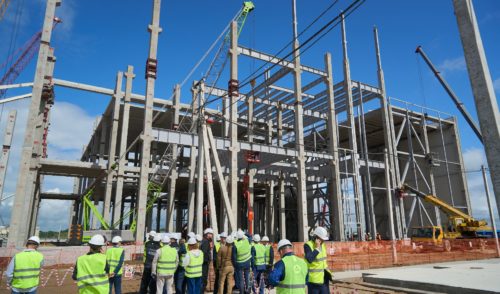
Latest News from Russian Nuclear Sites
back to contentsKursk NPP
All-out construction started off at Kursk-2. “We have begun the construction of a VVER-TOI based nuclear station, the most advanced and sophisticated project for now. Each unit of the new station will have a capacity of 1,255 MW,” said Nikolai Mitrofanov, Head of Kursk-2 Construction Office.
It was noted that Kursk-2 was specifically designed to use primarily domestic equipment. Vessels and steam generators for the VVER-TOI reactors will be manufactured by Rosatom’s subsidiary Atommash (Volgodonsk, Russia). Power Machines (Saint Petersburg) will make turbines. Core catchers will be produced by Energotex (Kurchatov, Russia) while nuclear fuel will be supplied by TVEL.
Rostov NPP
As we reported earlier, welding on the main circulation circuit of Rostov Unit 4 was completed within a record short period. This enabled to start preparations for the reactor piping leak detection, which is scheduled for December.
Installation of the new equipment is now running full-tilt. In the reactor island, electrical wiring is being done on the fuel loader to be commissioned in August.
The reactor turbine is also in the process of installation, with 60% of the work already completed.
The turbine shaft has been aligned to a hundredth fraction of a millimeter so that the rest of concrete can be added to fix the supports of turbine rotors. Fit-up tests have begun to check the assembly of low-pressure cylinders. The turbine will be fully assembled and mounted on the barring gear by May 2017 to signal that the secondary circuit equipment is ready to generate electricity.
Novovoronezh NPP
The innovative Unit 6 of Novovoronezh NPP is expected to begin generating power in the coming weeks, said NPP Director Vladimir Povarov. Earlier the unit was reported to go critical.
In the meantime, the third (and the uppermost) tier of the external containment dome was placed in its permanent position at Unit 7. Its double (internal and external) containment rules out radioactive emissions and protects the internals from external influence, both natural and man-made (including earthquakes, hurricanes, and plane crashes).
The mounting was preceded by pre-assembly of its structural parts (reinforced concrete blocks) at the ground level to ensure high quality of mounting operations. The total weight of the third tier approximates 160 tons.
Requirements for the installation are stringent as the deviations must not exceed 10 mm. For this reason, the task was performed by highly qualified and experienced workers. Concreting of the external containment dome will be the next step in the construction process.
Beloyarsk NPP
In June, Beloyarsk NPP Unit 4 featuring a BN-800 fast reactor generated its billionth kilowatt-hour. This is a total amount of electric power produced since December 2015 when the unit was first connected to the grid.
“It is quite symbolic that this milestone was achieved on the eve of Russia Day. Fast reactors are now part of the energy supply program for future development of the national economy,” said the station’s representative.
Leningrad NPP
An important construction phase came to an end at Leningrad-2, which is designed to replace the existing Leningrad NPP. The automated process control system was finally energized at Unit 1 of the now constructed station.
“The connection of the process control system to the power supply is indeed a milestone for us,” said Alexander Rudnik, a deputy chief engineer in charge of automation at the new station. “This required an input from many qualified construction and installation workers who did a huge job to make it happen. The auxiliary power supply chain was connected step by step, with each component first adjusted off-line. To visualize the scale of this effort, imagine a reactor unit as a human body, where the control room is a brain and the process control system is a nervous system. This gives a clear idea of the role they play. The control system is not a mere collection of hundreds of electric components and thousands of kilometers of wires, but an essential tool that manages and controls all the equipment in the reactor and turbine islands.”
In addition, electric motors of the first four pumps in the reactor island were cranked to check their operability. This is one of the steps to prepare the pumps for non-pressure testing, when they are used to fill the reactor core emergence cooling system and the pressurizer with chemically demineralized water.
“At this stage, possible defects and malfunctions are identified to be subsequently eliminated. This time the testing was a success as it confirmed basic parameters and specifications of the electric motors,” explained Alexei Mochalov, a deputy manager of the reactor island department at the now constructed Leningrad NPP-2.




